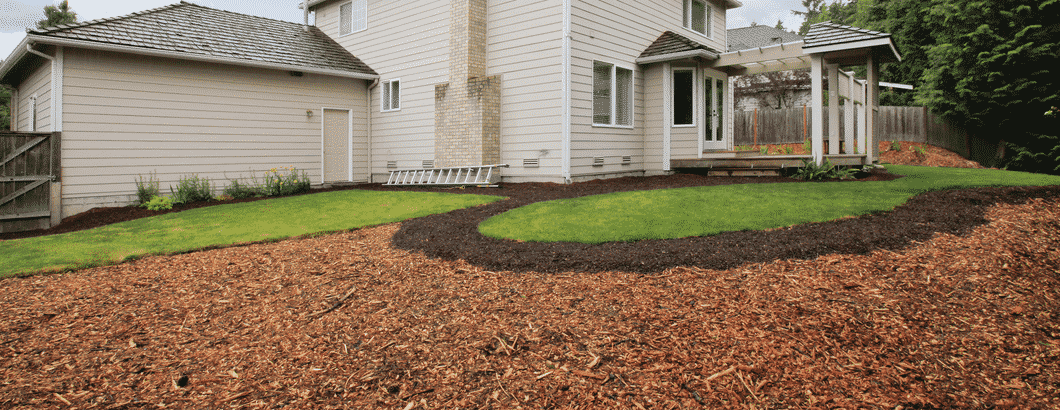
Maximizing the Lifespan of Your Mulch
Landscaping and gardening can take quite a bit of time and effort. That is why it is important to know exactly when to refresh your landscape by replacing the mulch.
When you replace mulch too early or too often you spend more time, energy, and money than is necessary. On the other hand, if you do not replace mulch often enough it can start to fade and breakdown, hindering it from doing its job of protecting your plants. We’ve laid out ways to maximize the lifespan of your mulch.
How Often Should Mulch be Replenished?
No matter what type of mulch you use in your lawn or garden, the timeframe to replenish it is about the same. On average, you should replace mulch every 1-2 years.
Your mulch should be replaced every 1-2 years (on average).
If your mulch seems to be less thick than when you first installed it, it is probably a sign that it is breaking down and dissipating into the soil. However, this is not the only reason your mulch might need replacing.
Reasons to Replace Mulch
Fading Colors
All mulch will lose its color over time. Some mulches will lose their hue quicker than others, however. Specifically dyed mulch varieties tend to be shorter lasting. With dyed mulch, you will want to replace it every 1-1 ½ year.
Direct and extended exposure to sunlight will also speed up the color loss in the mulch. If your landscape, or parts of it, tend to be in direct sunlight most of the day then they will likely need replacing before other parts of your yard.
The bleaching effect of sunlight is pretty much unavoidable unless your mulch is used under and around trees or shrubs. They will provide some shade to extend the color-life of your mulch.
Organic Breakdown
The organic breakdown of mulch is a natural process that actually helps your plants by infusing them with added nutrients. This is one of the benefits of using mulch.
As mulch breaks down, it gives back to the soil making your garden or landscape more fertile. However, as your mulch breaks down it no longer serves as a protective covering to retain moisture and discourage weed growth. When this happens you are nearing the end of the lifespan of your mulch. This is why it needs to be replaced, but not more often than every 1-2 years.
Wood chip mulch breaks down more slowly than shredded mulch varieties. Wood chips also tend to have more chemical diversity in their makeup because they include pieces of leaves, tree bark, and several tree varieties (including sapwoods and hardwoods). This means that while the wood chips are breaking down there is even more added nutrients from organic matter being added to your soil. According to Texas A&M Agrilife:
“Using locally produced wood chips is a sustainable activity, keeping a useful product out of the landfill, which is both environmentally and economically a good thing.”
At Gaston, we offer pine wood chips and IPEMA certified wood chips. IPEMA certified wood chips are great for playgrounds or areas where children play frequently. All of our wood chips are naturally bug-resistant.
Natural Disasters
If you have ever experienced flooding, you probably needed to replace your mulch afterward. Since mulch is a wood product it will float and can be carried away, sometimes even by heavy rains. In these (hopefully uncommon) cases the 1-2 year rule does not apply.
If you are concerned that flooding is a common issue in your area, it is a good idea to stay away from pine bark nuggets. Even though these last longer than shredded mulches, the large bark chunks tend to float away easily in heavy rains.
Here in Florida, rain is an everyday occurrence in the summertime. However, this doesn’t mean that all rainfall is a threat to your mulch. Your landscape needs rain and moisture to survive. Being aware of the weather patterns in your area and your elevation will best help you decide if flooding will be an issue.
Making the Most of Your Mulch
Proper installation and care of your mulch beds will help them stay in good condition longer. Here are some steps you can take to extend the lifespan of your mulch (even before you begin laying it)!
1. Pull Weeds
One of the benefits of laying mulch is that it prevents new weed growth. To help your mulch perform, you should rid your garden beds of any pre-existing weeds and plant growth. You can also use an herbicide before spreading mulch to ensure weeds are completely eliminated.
2. Trim Trees and Shrubs
Overhanging trees and nearby shrubs or bushes can create debris. Trimming these back before mulching will decrease any debris.
3. Clean Out Beds
Similar to pulling all remaining weeds, you also want to clear out any dead leaves, trimmings, or last year’s mulch. This prepares a clean slate for your new mulch. Before spreading, make sure you break up any soil that has been compacted. You can quickly and easily do this with a rake and it will allow air and moisture to pass freely.
4. Maintain Beds Monthly
Once a month, it is a good idea to continue loosening mulch because it will begin to compact as it breaks down. Like in the previous step, when you break up the mulch on top it allows more air and moisture to travel to the plant’s roots. It also prevents the growth of fungi and can spruce up the appearance of your mulch beds.
Invest in Quality Mulch
At Gaston Mulch and Soil, we produce a variety of quality mulches. We offer hardwood mulch, dyed pine mulch, cypress blends, as well as wood chips, pine straw, and pine bark nuggets. Check out our website or contact us to order today!
